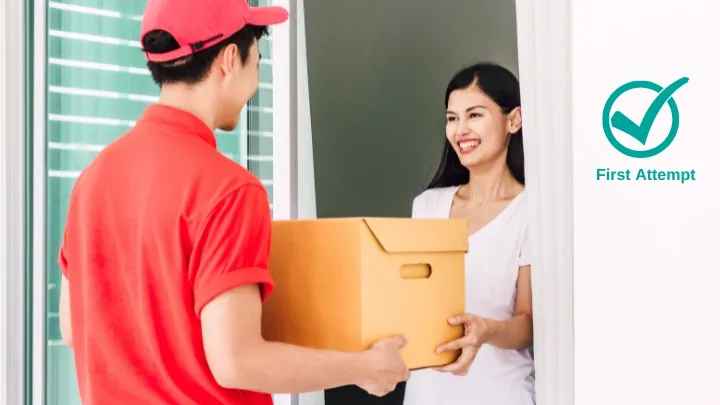How to Measure Delivery Performance: 9 KPIs and Metrics you Should be Measuring
The key performance indicators you should be tracking. Learn how to measure delivery performance with data-driven insights and advanced route planning.

In delivery operations, the seamless and efficient movement of goods from point A to point B is not just a necessity but a critical component of success. Whether you handle goods as the core of your business or as an essential part of your operations, delivery performance is the lifeline that connects you to your customers. By analyzing and understanding your delivery performance, you gain access to the insights required to make informed decisions, streamline processes, and optimize resources. Most importantly, you gain the ability to fine-tune your services to align with customer demands and exceed their expectations.
In this blog post, we will explore the concept of delivery performance and the factors that can significantly impact it, and provide invaluable insights into nine essential key performance indicators (KPIs) and metrics that should be measured and tracked.
What Can Affect Your Delivery Performance?
Why it’s Important to Measure Delivery Performance
9 Delivery Performance KPIs & Metrics You Should be Measuring
What is Delivery Performance?
Delivery performance refers to how effectively and efficiently a business handles its delivery operations. It is a measure of the success rate in meeting customer expectations and ensuring timely and accurate deliveries. For businesses that handle goods, be it as their primary focus or as part of their operations, delivery performance plays a critical role in customer satisfaction and overall success. By monitoring and analyzing delivery performance, businesses can identify areas for improvement and implement strategies to enhance their delivery management.
Efficient delivery performance ensures that resources are utilized optimally, costs are minimized, and customers are delighted with the promptness and reliability of your services. Monitoring and analyzing delivery performance through the lens of specific KPIs and delivery metrics empower businesses to identify strengths, weaknesses, and areas for improvement.
What Can Affect Your Delivery Performance?
Route Optimization: Inefficient route planning can lead to longer delivery times, increased fuel costs and reduced overall productivity. Delivery vehicles may end up taking suboptimal paths, leading to unnecessary delays and higher operational expenses.
Vehicle Maintenance: The reliability of delivery vehicles plays a pivotal role in on-time deliveries. Properly maintained vehicles are essential for ensuring that goods reach their destinations as scheduled and for preventing unexpected breakdowns that can disrupt the delivery schedule.
Inventory Management: Accurate inventory data is the backbone of successful deliveries. Without precise information on available stock, businesses risk encountering delays due to stockouts or errors in fulfillment.
External Factors: The dynamic nature of the external environment can pose challenges to delivery performance. Weather conditions, road closures, traffic congestion, or unforeseen events can disrupt delivery schedules and impact delivery performance. While these external factors may be beyond a business's control, having contingency plans and leveraging real-time data and analytics can help businesses adapt swiftly and minimize the impact on delivery operations.
Communication and Coordination: Effective communication and coordination are vital for seamless and successful deliveries. Drivers, dispatchers, and customers must be in sync throughout the delivery process to ensure that goods are delivered accurately and on time. Ineffective communication can lead to confusion, missed deliveries, and dissatisfied customers.
SmartRoutes Route Planning Software
Streamline your entire delivery process, all from one platform

Why it’s Important to Measure Delivery Performance
Let's explore some compelling reasons why measuring delivery performance is crucial for businesses:
Customer Satisfaction
At the heart of every successful business lies a satisfied and loyal customer base. Delivery performance plays a pivotal role in shaping customer satisfaction. When customers receive their orders on time and with accuracy, it creates a positive experience that fosters trust and loyalty. Satisfied customers are not only more likely to become repeat buyers but also enthusiastic advocates who recommend your services to others, amplifying your brand's reach and impact.

Operational Efficiency
Measuring key performance indicators (KPIs) and metrics related to delivery performance provides businesses with invaluable insights into their operational efficiency. A delivery performance report identifying bottlenecks, inefficiencies and areas for improvement, businesses can optimize their delivery processes. Streamlined operations translate to reduced delivery times, improved productivity, and lower operational costs. With efficient delivery operations, businesses can effectively allocate resources and make the most out of their time and budget.
Cost Optimization
Understanding delivery costs is essential for optimizing resources and improving overall profitability. Measuring delivery performance metrics such as average cost per delivery allows businesses to pinpoint areas where expenses can be minimized. From fuel costs and vehicle maintenance to labor and routing inefficiencies, identifying cost-saving opportunities helps businesses operate in a financially sustainable manner, enhancing the bottom line.
Competitive Advantage
Consistently delivering on promises and exceeding customer expectations sets your business apart from competitors. As your reputation for reliable and efficient delivery services grows, you gain a competitive advantage that attracts new customers and retains existing ones.
Continuous Improvement
Regularly measuring delivery performance allows businesses to stay nimble and adapt to changing market demands. By identifying areas for improvement, businesses can proactively implement changes, optimize their services, and maintain a high standard of delivery performance that aligns with evolving customer needs.
9 Delivery Performance KPIs & Metrics You Should Be Measuring
Understanding how to measure delivery performance is key to improving efficiency and keeping customers happy. The right KPIs and metrics help track everything from on-time rates to customer satisfaction, giving you the insights needed to refine your delivery process. Here are the top ones to focus on:
1. Number of Completed Deliveries
The number of completed deliveries is a very worthy measure of success as it highlights the efficiency and effectiveness of a business's delivery operations. This fundamental metric offers a comprehensive overview of the total number of successful deliveries accomplished within a specific time frame. This metric goes beyond simply telling us how many deliveries are complete as it shows the careful planning, diligent execution, and the commitment to delivering on promises made to customers. As this metric grows, so does the evidence of the business's reliability and commitment to customer satisfaction.
While a high number of completed deliveries is indicative of success, it can also reveal potential challenges. A sudden surge in deliveries that stretches operational capacity may lead to delays or errors. By closely monitoring this metric, businesses can proactively identify capacity constraints and allocate resources efficiently to maintain a consistent level of service.
2. Order Accuracy
This critical performance indicator measures the percentage of deliveries completed without errors, ensuring that the right items, in the correct quantities, reach customers as intended. In the pursuit of seamless and efficient deliveries, order accuracy emerges as a key touchpoint that can either elevate a business's reputation or lead to customer dissatisfaction.
The impact of order accuracy on customer satisfaction cannot be overstated. When customers receive the exact items they ordered, it fosters a positive and gratifying experience. In contrast, inaccuracies such as wrong items or quantities lead to frustration, inconvenience, and erode trust in the business's ability to deliver reliable services. Achieving and maintaining a high level of delivery accuracy is vital for nurturing loyal and repeat customers, which ultimately contributes to the long-term success of the business.
Order accuracy is not solely reliant on chance; it is the result of well-structured systems and efficient processes. Implementing advanced inventory management systems, employing barcode and scanning technologies, and adopting rigorous quality control measures all play instrumental roles in ensuring accurate order fulfillment.
3. First Attempt Delivery Rate
This key performance indicator (KPI) measures the percentage of deliveries successfully completed on the initial delivery attempt, without the need for re-deliveries or additional attempts. A high first attempt delivery rate signifies a well-orchestrated and efficient delivery process that not only saves time and resources but also enhances customer satisfaction.

Every successful delivery on the first try not only minimizes operational costs but also provides a seamless and positive experience for the customer. This successful execution is the result of a harmonious alignment between effective routing, accurate scheduling, and meticulous planning.
Achieving a high first attempt delivery rate relies on the art of efficient routing and scheduling. Optimized routes and well-coordinated schedules ensure that delivery personnel can reach their destinations with precision and minimal delays. By strategically planning delivery routes and factoring in real-time traffic data, businesses can increase the chances of completing deliveries on the first attempt, saving time and reducing fuel costs.
4. On-Time Delivery
The on-time delivery rate measures the percentage of deliveries completed within the promised timeframe, reflecting a business's ability to meet customer expectations and adhere to agreed delivery schedules. When customers receive their orders on time, they are more likely to feel valued and appreciated, leading to positive reviews, repeat business, and word-of-mouth referrals.
On-time delivery metrics indicate if the business has a well-organized delivery process, optimized routes, and accurate scheduling. By continuously striving to achieve high on-time delivery rates, businesses can streamline their operations and ensure that customers can rely on consistent and predictable delivery experiences.
Achieving on-time delivery is not without its challenges, factors such as weather conditions, traffic congestion, or unforeseen events can disrupt delivery schedules. Businesses that proactively address these challenges and have contingency plans in place demonstrate resilience and commitment to delivering on time, even in the face of adversity.
5. Average Time Per Delivery
The metric of average time per delivery is a critical performance indicator that provides valuable insights into the efficiency of a business's delivery process. This key metric measures the average duration it takes to complete a delivery from the moment the goods leave the fulfillment center to their arrival at the customer's doorstep. Businesses can use this metric to set performance benchmarks, measure progress, and compare performance across different time periods.
Analyzing the average time per delivery enables businesses to pinpoint inefficiencies in their delivery process. Long delivery durations may indicate factors such as suboptimal routing, inadequate vehicle capacity utilization, or delays in order processing. By identifying these pain points, businesses can take targeted measures to address them and enhance overall delivery efficiency.
Efficient route planning and scheduling play a crucial role in reducing the average time per delivery. Businesses can leverage advanced routing software and real-time traffic data to optimize delivery routes, minimize travel time, and decrease the chances of delays.
6. Average Cost Per Delivery
The average cost per delivery is an essential performance indicator that measures the average expenses incurred to fulfill each delivery, encompassing a range of factors such as fuel costs, labor, maintenance, and vehicle depreciation.
By breaking down the cost components, businesses gain valuable insights into the financial implications of their delivery operations. This data-driven approach enables businesses to make informed decisions about resource allocation and cost management. For example, if fuel costs are significant, businesses can explore fuel-efficient vehicles, optimize delivery routes to reduce travel distance, or explore alternative delivery methods to lower fuel consumption. Understanding these cost drivers is vital for implementing targeted cost-saving measures.
7. Out-Of-Route Miles
The metric, out-of-route miles, measures the distance covered by delivery vehicles that deviate from the most efficient delivery route. By comparing the actual travel distance with the most efficient route, businesses can identify deviations and areas for improvement. These extra miles add unnecessary fuel costs, increase delivery times, and contribute to operational inefficiencies.
Reducing out-of-route miles directly impacts fuel efficiency, which is not only beneficial for cost savings but also for environmental sustainability. By optimizing routes and minimizing unnecessary travel, businesses can lower fuel consumption, reduce greenhouse gas emissions, and contribute to environmentally responsible practices.
Out-of-route miles can lead to longer delivery times, impacting customer experience. By streamlining routes, businesses can improve delivery times, boost customer satisfaction, and nurture long-lasting customer relationships.
8. Vehicle Capacity Utilization
This essential performance indicator measures the percentage of a delivery vehicle's capacity that is utilized during each trip. For businesses that handle deliveries in varying quantities, maximizing vehicle capacity utilization is paramount to achieving efficient operations, reducing the number of required trips, and ultimately lowering delivery costs.

By understanding how much of a vehicle's capacity is utilized for each delivery, businesses can strategically plan delivery routes to maximize the load per trip. This optimized resource allocation leads to reduced fuel consumption, lower vehicle maintenance costs, and enhanced overall operational efficiency. A high vehicle capacity utilization directly translates to the reduction in the number of required trips to fulfill deliveries. With fewer trips needed to transport goods, businesses can achieve greater delivery efficiency, streamline operations, and minimize the impact on the environment. This streamlined approach contributes to cost savings and a more sustainable delivery process.
9. Net Promoter Score (NPS)
The Net Promoter Score (NPS) is a metric that delves into the realm of customer satisfaction and loyalty. While not directly tied to the delivery process itself, the NPS offers a valuable glimpse into the hearts and minds of customers. It provides businesses with a clear indication of how satisfied customers are with the delivery experience and their likelihood of recommending the delivery services to others. As a holistic indicator of customer sentiment, a high NPS can pave the way for increased customer loyalty, positive word-of-mouth referrals, and enduring success in the competitive market.
While a high NPS is an achievement to celebrate, the feedback from customers, including Passives and Detractors, holds invaluable insights for continuous improvement. By actively seeking feedback and listening to customer concerns, businesses can identify areas for enhancement, address pain points, and further elevate the customer experience.
Improve On Your Delivery Performance with SmartRoutes
At SmartRoutes, we recognize the important role delivery performance plays in the success of businesses. Our comprehensive platform is designed to empower businesses with robust tools and cutting-edge analytics, helping them optimize routes, reduce costs, and elevate overall delivery efficiency. With SmartRoutes at your side, you can harness the power of data-driven insights and advanced route planning to improve your delivery performance, boost customer satisfaction, and gain a competitive advantage in the market.
SmartRoutes provides you with a comprehensive view of key delivery metrics, including on-time delivery rates, vehicle capacity utilization, and average time per delivery. Armed with this data, you can make informed decisions, identify areas for improvement, and implement proactive measures to optimize your delivery processes. Our platform ensures that drivers take the most efficient path, reducing out-of-route miles and enhancing the chances of completing deliveries on the first attempt.
Experience the power of SmartRoutes with our free 7-day trial. During this trial period, you'll have the opportunity to explore our platform, access our robust features, and witness firsthand the impact of data-driven delivery optimization.
Frequently asked questions
1. What are Key Performance Indicators (KPIs) for measuring delivery performance?
Key Performance Indicators, or KPIs, are specific delivery metrics that help businesses measure and evaluate their delivery performance. In the context of delivery, common KPIs include On-Time Delivery (OTD), Delivery Time Variance, Order Accuracy, Cost per Delivery, Return Rates, and Customer Satisfaction. These metrics offer insights into various aspects of your delivery operations.
2. How do I calculate on-time delivery performance?
To calculate on-time delivery performance, use the following formula:
On-Time Delivery Performance (%) = (Number of On-Time Deliveries / Total Deliveries) x 100
This formula calculates the percentage of deliveries that were made on time out of the total deliveries.
3. What are the industry benchmarks for delivery performance metrics?
Industry benchmarks for delivery performance can vary by sector and location. For instance, in e-commerce, an industry benchmark for On-Time Delivery might be around 95%. However, it's essential to research benchmarks specific to your industry and region for a more accurate comparison.
4. What tools or software can help track and analyze delivery performance metrics?
There are several tools and software solutions that can help you track and analyze delivery performance metrics. Some popular options include route optimization software like Smartroutes.io, delivery management systems, customer relationship management (CRM) software, and transportation management systems (TMS). These tools can help you collect, analyze, and visualize your delivery data effectively.
5. How can I use these shipping metrics to improve my delivery operations?
To improve your delivery operations using metrics, follow these steps:
- Identify areas of improvement based on the KPIs and metrics.
- Set specific, measurable, and achievable goals for each metric.
- Implement changes and strategies to address the identified issues.
- Continuously monitor and analyze the metrics to assess progress.
- Adjust your operations and strategies as needed to achieve your delivery performance goals. Regularly tracking and acting on these metrics can lead to more efficient and customer-centric delivery operations.
If you enjoyed this blog, you might also be interested in:








